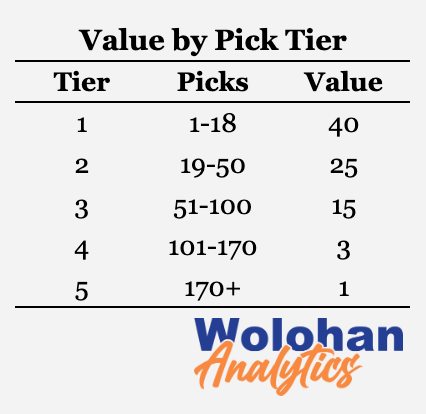Value and the NFL Draft
The NFL draft is exciting. So exciting that many wanna be general managers actually replicate the experience for themselves—drafting and managing their own fantasy teams. For some, the draft is the highlight of the fantasy season. For others, the draft is the highlight of the football season.
If you pay attention to sports, you likely think about drafts as slightly more sophisticated version of picking teams on the playground.
Indeed, this is probably how many general managers think about the draft.
Others might imagine that the draft is like hiring a movie star, or any other job candidate.
Both of these are wrong.
Drafts are interesting because every team in the league gets a pick. And the value of the players available at that pick is unknown. So there are two questions:
Who can I get at the spot that I’m at now?
And how good are they relative to the value other teams in the league might be willing to pay for this spot?
The first question is quite hard. And mostly everyone does a terrible job at this. Something like half of first round quarterbacks drafted are unquestionable busts.
The second question, is easier.
I break the draft into five groupings, based on the average value of players at those positions, based on expected games played, starts, and pro bowls.
Elite Picks (1-18)
Good Picks (19-50)
Okay Picks (50-100)
Role Player Picks (100-170)
Flyers (170+)
Elite Picks. In the first 18 picks, you must draft a Pro Bowler. There are plenty of them on the board. If you are picking in this area and you miss, that’s a big mistake. These players are expected to be high impact players in the league for at least 5 or 6 seasons.
Good Picks. Unlike the elite picks, we shouldn’t expect Pro Bowlers here, but we should be looking to draft players who are solid starters, with upside. There are still plenty of elite impact players on the board in this range.

Okay Picks. From 50 to 100, we’ve mostly run out of immediate impact talent. You’re looking for players who can start for a few seasons and contribute.
Role Player Picks. From 100 to 170, we’re looking at players who likely won’t get a full season of starts in their career, so finding players who can start a year or two is the goal.
Flyers. From 170 on, we have no expectations. We expect these players to last about two or three years in the league, almost never starting. Anything more in terms of longevity or impact is a win.
Pick Value
There are lots of charts. and strategies out there about how much each individual pick is worth—including the famous Jimmy Johnson draft chart. And it is true: with every spot in the draft you go down, the value is a bit worse. But for the most part, moving one slot up or down is not impactful. Teams make so many mistakes in the draft—overlooking the best players, overvaluing poor performers—that it is almost a rule that many worse picks will be better than a smaller number of slightly better picks.
A tier based approach to value recognizes the general level of performance you are hunting for in each group, and what that means to your team.
Tier 1 is worth about 40 Tier 5 picks for instance, or two Tier 2 picks, or about three Tier 3 picks.
Keep in mind, this is all in terms of on-field performance. When it comes to the market value, the picks are ultimately worth whatever someone is willing to trade for them. Which can be quite a bit higher than the expected, on-field value.
There is also a time-premium for picks this year, versus in future years. Because the NFL—and really all sports leagues—are “win now” leagues, there is about a 50% discount placed on the value of a pick in a future year. So a future tier 1 pick is worth only about 20 points—less than a current day tier 2 pick.
What should your team do?
If your team has a premium pick, and you feel like one great player can put you over the edge—say you’re drafting in the 12-18 range—then by all means, pick that player. Teams in the 1-11 range are probably bad enough that they are outside of that window, and should strongly consider trading down, where the value will be better and they can impact more of their roster.
Teams whose top pick is in Tier 2—the best teams in the league—are hunting for value and hoping teams above them miss. These teams do not really have the luxury of drafting for need, because it will be too difficult to find the really good players in this Tier, while also restricting by position. These teams should draft purely for value.
As you get into your team’s Tier 3 and beyond picks, this is where you want to be drafting positionally, filling in depth, and hoping to find diamonds in the rough.
If I’m drafting in the top of the draft, I’m probably looking to trade down in Tier 1, and hoping to pick up a can’t-miss cornerback or wide receiver. There is an absurd amount of athleticism in this draft at those positions.
Much has been made about the quarterback prospects of this draft. But all of them have flaws or question marks. If we see five go in the first round, don’t be surprised if three are outright busts.




